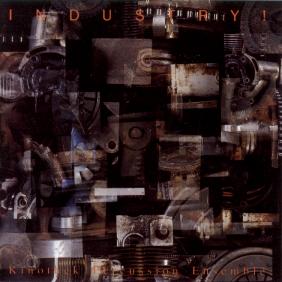Kinothek Percussion Ensemble
INDUSTRY !
 |
1. The Flywheel Gives A Steady Momentum
2. Rotary Movement Of The Ratchet-Faced
Wheel By The Pawls
3. The Trunnions Are United And Turn
Together On The Shaft
4. The Oscillation On The Tappet-Arm By
Compression
5. A Series Of Cams Of Varying Throw
6. Vertical Percussiv Falls Derived From
Rotating Shaft
7. An Aggregate Rotation Is Given To
The Roller-Whell
8. An Arrangement Of Parallel Motion
9. Piston-Driven Friction Rollers
10. Irregular Circular Motion Imparted To
An Elliptical Spur-Gaer
11. Pinion Driven Alternately By External
And Internal Mutilated Cogwheels
12. Friction Describes The Great Circumference |
|
|
nml/D 873 CD 1992 54'58"
|
KINOTHEK PERCUSSION ENSEMBLE consist of Californian composer,
musician & performer DNA HOOVER. Using percussion instruments as well as found
objects, his main "instrument" is a multitrack studio where he puts together
what will later form his albums: musical pieces, arranged by dramatic mood and
style, dealing with thematic film music.
The original principle of KINOTHEK was developped in 1919 by Italian composer
Guiseppe Becce who published "Kinobibliothek", a catalogue of film scores from
which theatre music directors could choose appropriate pieces to accompany the
films (which then didn't have soundtracks) that were shown at that time. "Kinobibliothek"
was the most succesful among other catalogues and soon became the industry standard;
later, they all were referred to as "Kinothek".
DNA HOOVER not only adopted the name "Kinothek", but also works in a familiar
way like Becce - instead of written compositions, he published records containing
music for films - real ones or for the "cinema in the head".
On "Industry !", Hoover has enlargened his musical "bibliothek" with lots of
"found" sounds from mechanical sources; these sounds form a system of interactive
"templates", creating a shifting wash of polyrhythms, based on 55,110,165 and
220 beats per minute. Listening to the record may be like a walk through an
imaginary factory; not harsh noise, but subtile, repetitive and dense soundscape
of mechanical contraptions, more familiar to ambient sounds than to the clumsiness
of the socalled Industrial scene.
"The music ... is appropriately evocativ, almost visual. ...
some verge on ambient music, while others are less specific, though no less
provocative. Lots of wonderful music and sounds are captured here."
(Dean Suzuki, Option)
"Regarding the inflationary use of the phrase "avantgarde"
connected with "industrial", one needs to focus on the essence from
time to time. And this is what happens here."
(OXMOX)
